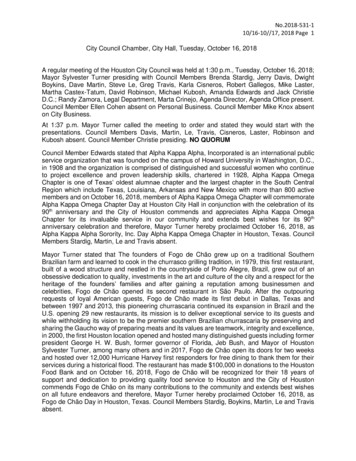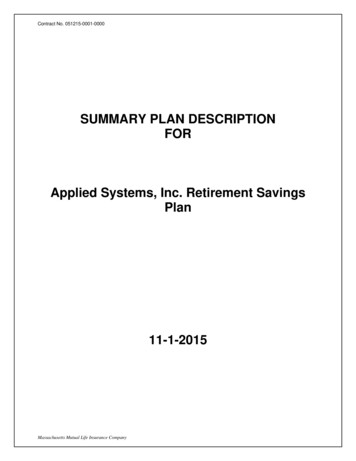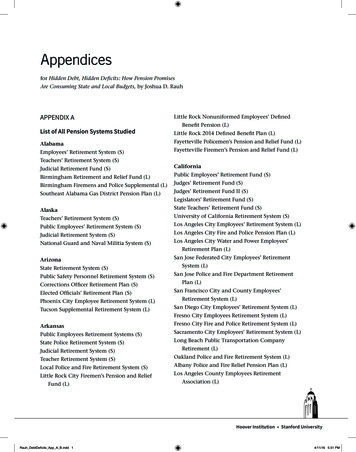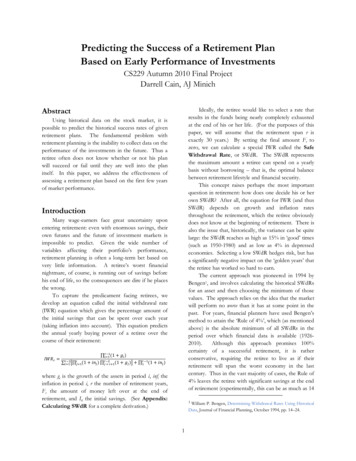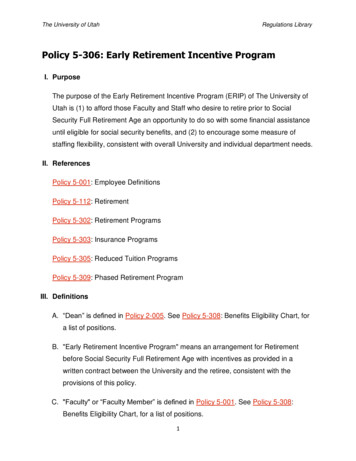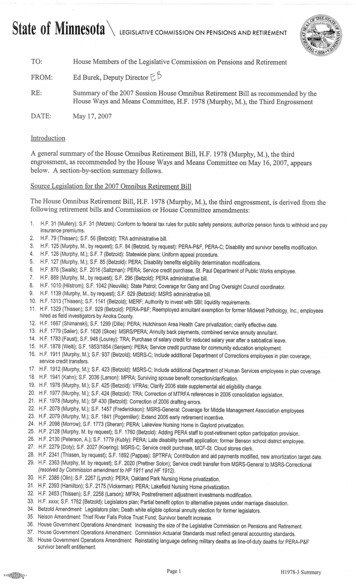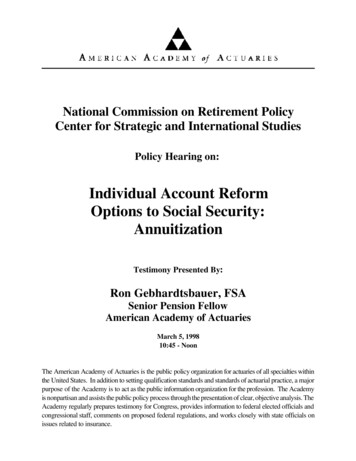
Transcription
National Commission on Retirement PolicyCenter for Strategic and International StudiesPolicy Hearing on:Individual Account ReformOptions to Social Security:AnnuitizationTestimony Presented By:Ron Gebhardtsbauer, FSASenior Pension FellowAmerican Academy of ActuariesMarch 5, 199810:45 - NoonThe American Academy of Actuaries is the public policy organization for actuaries of all specialties withinthe United States. In addition to setting qualification standards and standards of actuarial practice, a majorpurpose of the Academy is to act as the public information organization for the profession. The Academyis nonpartisan and assists the public policy process through the presentation of clear, objective analysis. TheAcademy regularly prepares testimony for Congress, provides information to federal elected officials andcongressional staff, comments on proposed federal regulations, and works closely with state officials onissues related to insurance.
Table of ContentsIntroduction: . . . . . . . . . . . . . . . . . . . . . . . . . . . . . . . . . . . . . . . . . . . . . . . . . . . . . . . . . . . . . . . . . . . 2What are the advantages of annuities? . . . . . . . . . . . . . . . . . . . . . . . . . . . . . . . . . . . . . . . . . . . . . . 2Payable for life: . . . . . . . . . . . . . . . . . . . . . . . . . . . . . . . . . . . . . . . . . . . . . . . . . . . . . . . . . . 2Larger monthly income: . . . . . . . . . . . . . . . . . . . . . . . . . . . . . . . . . . . . . . . . . . . . . . . . . . . . 2Spread out evenly for life: . . . . . . . . . . . . . . . . . . . . . . . . . . . . . . . . . . . . . . . . . . . . . . . . . . . 2Annuities have tax advantages: . . . . . . . . . . . . . . . . . . . . . . . . . . . . . . . . . . . . . . . . . . . . . . . 2Relieves pressure on government programs: . . . . . . . . . . . . . . . . . . . . . . . . . . . . . . . . . . . . . 2Inflation-Indexed Annuities: . . . . . . . . . . . . . . . . . . . . . . . . . . . . . . . . . . . . . . . . . . . . . . . . . 3Why don’t people buy annuities? . . . . . . . . . . . . . . . . . . . . . . . . . . . . . . . . . . . . . . . . . . . . . . . . . . 3Fear that they will die early: . . . . . . . . . . . . . . . . . . . . . . . . . . . . . . . . . . . . . . . . . . . . . . . . . 3Liquidity & Extra Ordinary Expenses: . . . . . . . . . . . . . . . . . . . . . . . . . . . . . . . . . . . . . . . . . . 4They have enough income: . . . . . . . . . . . . . . . . . . . . . . . . . . . . . . . . . . . . . . . . . . . . . . . . . . 4They want to pass the money to heirs: . . . . . . . . . . . . . . . . . . . . . . . . . . . . . . . . . . . . . . . . 4Financial Advisor: . . . . . . . . . . . . . . . . . . . . . . . . . . . . . . . . . . . . . . . . . . . . . . . . . . . . . . . . . 4They think they can do better: . . . . . . . . . . . . . . . . . . . . . . . . . . . . . . . . . . . . . . . . . . . . . . . . 4Life Insurance Agents don’t push annuities as much: . . . . . . . . . . . . . . . . . . . . . . . . . . . . . . . 4Lack of inflation protection: . . . . . . . . . . . . . . . . . . . . . . . . . . . . . . . . . . . . . . . . . . . . . . . . . 4What happens if people don’t buy annuities? . . . . . . . . . . . . . . . . . . . . . . . . . . . . . . . . . . . . . . . . . . . 5Live beyond income: . . . . . . . . . . . . . . . . . . . . . . . . . . . . . . . . . . . . . . . . . . . . . . . . . . . . . 5Withdraw too fast or too slow (leakage): . . . . . . . . . . . . . . . . . . . . . . . . . . . . . . . . . . . . . . . 5Government assistance: . . . . . . . . . . . . . . . . . . . . . . . . . . . . . . . . . . . . . . . . . . . . . . . . . . . 5Should we mandate annuities? . . . . . . . . . . . . . . . . . . . . . . . . . . . . . . . . . . . . . . . . . . . . . . . . . . . . . 5Poverty rates for very elderly could increase if leakage allowed: . . . . . . . . . . . . . . . . . . . . . . . 6People don’t buy annuities and Defined Benefit plans are decreasing: . . . . . . . . . . . . . . . . . . 6Minimum Annuity Poverty: . . . . . . . . . . . . . . . . . . . . . . . . . . . . . . . . . . . . . . . . . . . . . . . . 6Minimum SSA benefit Poverty: . . . . . . . . . . . . . . . . . . . . . . . . . . . . . . . . . . . . . . . . . . . . . 6Encourage good behavior to get waiver: . . . . . . . . . . . . . . . . . . . . . . . . . . . . . . . . . . . . . . . . 6Aren’t liquid assets needed too? . . . . . . . . . . . . . . . . . . . . . . . . . . . . . . . . . . . . . . . . . . . . . . 6Should sick people be forced to buy an annuity? . . . . . . . . . . . . . . . . . . . . . . . . . . . . . . . . . . 6If sick get breaks, what about others? . . . . . . . . . . . . . . . . . . . . . . . . . . . . . . . . . . . . . . . . . . 7Who should sell the annuities? The government or the private sector? . . . . . . . . . . . . . . . . . . . . . . . . 7Indexed Annuities may not be easily created: . . . . . . . . . . . . . . . . . . . . . . . . . . . . . . . . . . . . . 7Capacity: . . . . . . . . . . . . . . . . . . . . . . . . . . . . . . . . . . . . . . . . . . . . . . . . . . . . . . . . . . . . . . . 7Small account problem: . . . . . . . . . . . . . . . . . . . . . . . . . . . . . . . . . . . . . . . . . . . . . . . . . . . . 7Unisex problem: . . . . . . . . . . . . . . . . . . . . . . . . . . . . . . . . . . . . . . . . . . . . . . . . . . . . . . . . . . 7Insurance companies may charge more: . . . . . . . . . . . . . . . . . . . . . . . . . . . . . . . . . . . . . . . . 7Insurance Companies can go bankrupt: . . . . . . . . . . . . . . . . . . . . . . . . . . . . . . . . . . . . . . . 8Why not use Pension Plans? . . . . . . . . . . . . . . . . . . . . . . . . . . . . . . . . . . . . . . . . . . . . . . . . . . . . . . . 8
Introduction: Good Morning Mr. Chairman, members and staff of the commission, and fellowpanelists. My name is Ron Gebhardtsbauer and I am the Senior Pension Fellow at the AmericanAcademy of Actuaries. The Academy is the nonpartisan public policy organization for actuaries in theUnited States and does not endorse legislation. Instead, we analyze legislation for its potentialadvantages and disadvantages relative to current law.In the interest of time, I have provided you with copies of my full statement on this subject, so that I canfocus on the most important points at this hearing, namely:What are the advantages of annuities? Why don’t people buy annuities? What happens if they don’t? Should we mandate annuities? Who should sell them? The government or the private sector?What are the advantages of annuities?Payable for life: Life annuities pay benefits for the lifetime of the annuitant or pensioner (and spouseor other beneficiary, if elected), no matter how long they live.Larger monthly income: They can pay a larger monthly income than you can, because they focus themoney on the insurable event. Money saved from someone that dies early does not increase theinsurer’s profit (unless many more die than expected). It is used to provide benefits for someone wholives a very long life. See discussion in Appendix A and charts.Spread out evenly for life: A life annuity ensures that income is spread out evenly for the rest of yourlife. In fact, you can’t duplicate this by paying yourself the same amount as an insurance companywould pay you. If you live beyond your life expectancy, your money will run out.Annuities have tax advantages: The investment return on an annuity is not taxed as earned (i.e.,larger amounts in the early years, decreasing as the funds decrease). It is assumed to be received inlevel amounts over one’s life expectancy and thus the compounding of interest is more effective. Thus,the taxes on annuities can be less than the taxes on savings accounts (or stocks if churned frequently,although the tax rates have been reduced for stocks sold after 18 months). Stocks that are held andpassed onto heirs have the best tax advantages. They never have to pay taxes on the gain at transfer.But then they can’t be received as income.Relieves pressure on government programs: Someone with both a pension from their employerand an annuity from their IRA is much less likely to need public assistance. They also ease the pressureon Congress to increase Social Security benefits.I have attached some charts which show some of these advantages of annuities. They show that payingbenefits over a fixed period equal to one’s life expectancy can mean that funds are exhausted (too soon4
for half the people). They also show that Minimum Required Distributions start falling after that point intime too. Level life annuities (without inflation adjustments) eventually seem small compared toexpenses that go up with inflation. Paying yourself the interest income (and dividends) from your fundsproduces a smaller benefit than the level life annuity (and thus falls behind inflation even worse) and isnot steady (unless you lock in a long duration bond).Inflation-Indexed Annuities: An inflation-indexed annuity would be best, but you can’t buy them yetfrom insurance companies (possibly due to the lack of buyers and a deep enough market in indexedTreasuries). Only Social Security and some defined benefit plans pay them. TIAA-CREF has avariable annuity using indexed Treasuries which come close.1 I hope that insurers start using indexedTreasuries to create them. Inflation-indexed annuities are also important to the government since theyare especially beneficial to older people, which is where we have the highest poverty rates (see Chart1). Poverty rates should also improve in the future as (1) the effects of more working women and (2)retirements affected by ERISA2 reach these older ages.Why don’t people buy annuities?Experience from most Insurance Companies and Defined Contribution plans, shows that most people(sometimes as high as 90%) do not annuitize, even when the money is already at the InsuranceCompany. Congress might consider requiring that 401(k) plans offer Joint and Survivor (J&S)annuities and encouraging Defined Benefit (DB) plans. Using the private sector more, could relievepressure on the annuitization mandates. TIAA-CREF (a DC plan with annuity guarantees) annuitizes amuch greater portion of its retirees than other DC plans 3. Defined Benefit plans mostly pay annuitiesbecause people often can’t get a lump sum or never really thought of the plan as accumulating a fund ofmoney for them. Social Security, of course, is the most successful DB plan at annuitizing, becausepeople can’t take their money out - it is always paid in annuity form.Some reasons why people take the money out at retirement are:Fear that they will die early: People worry about the possibility of dying so soon that they will lose alot of their money and that the Insurance Company will win (i.e. make a profit off them). People don’tseem to worry as much about living too long, because that is so far away. As discussed above, those1They don’t exactly increase by the CPI due to a high Assumed Interest Rate of 4%, complete participationeven on mortality and expenses, and valuation to market every month or year. It should track inflation closelyalthough it may be ½% or 1% lower, which enables a higher initial benefit. There is not enough history to study it.(Barry Black, FSA)2ERISA is a pension law enacted in 1974 which mandated J&S annuities, unless the spouse waives it.3This is because one could not get a lump sum prior to 1988 , their annual statements focus on annuitieslike a DB plan (not account balances), and agents don’t push the other options. Post-1988, the decision is up to theinstitution on whether to allow lump sums, minimum required distributions, etc. Still two-thirds or more elect lifeannuities, and total cash payments are very low.5
that die earlier than average enable the Insurance Company to pay benefits to those that live longer thanaverage. They don’t increase the Insurance Company’s profit (unless more die than expected). If theretiree doesn’t think they will live long, they can buy an annuity with a guaranteed return of principle.4Some insurers will also take into account your health status (if requested), which would give unhealthypeople a better annuity amount.Liquidity & Extra Ordinary Expenses: Some people don’t want to lock up all their money in anannuity. They want the liquidity, in case they need money for unusual health, drug, or long term careexpenses, or for an emergency (or to travel).They have enough income: Some people already have enough retirement income from SocialSecurity and their employment-based pensions. They don’t need more income.They want to pass the money to heirs: Some people may not need more income and may prefer toleave whatever is leftover to their heirsFinancial Advisor: They have a personal relationship with a financial advisor who says they can dobetter than the Insurance Company. (And so will the advisor.)They think they can do better: Many people think they can get a better return on their money byinvesting it themselves, but can they? If they are a risk-averse retiree, they may not do better than ifthey just bought an immediate annuity5. In fact, they may do worse if they live longer than average.However, if they can invest in stocks (because they are less risk averse and have money to risk and asolid foundation of Social Security and Employer Pension benefits) and don’t live longer than average,then they may do better.Life Insurance Agents don’t push annuities as much: Life Insurance Company agents sell lifeinsurance, because they can get great commissions. These same commission amounts on annuitieswould make the annuities totally uncompetitive in the market place (since they compete with partiallysimilar products, such as mutual funds), so the commissions on most immediate annuities are onlyaround 4%. (New York state won’t allow commissions over 7%.) Therefore, with smallercommissions, agents are less likely to push annuities, and thus, less are sold.Lack of inflation protection: Annuities without CPI increases don’t really protect a person fullyfrom longevity risk, because inflation can make the benefit almost worthless by age 95, if inflation ishigh. Only 2 Insurers sell annuities indexed to the CPI, even though the new CPI-indexed, 30-year4People don’t seem to mind paying insurance premiums for term life insurance, health insurance, flood orearthquake insurance, car or rental insurance, etc, and then not have a claim all year. But maybe that’s because theyhope not to have a claim. They seem to know that the money will go to those that do have a claim and they get thepeace of mind from being covered for a catastrophic event. Maybe it is because those premiums are small comparedto the price of an annuity. If you die early, you can lose a lot of money from an annuity. If you don’t have a caraccident for a whole year, you’ve only lost one year’s car insurance premium, which is much less. And each yearyou get to decide whether you want to pay another premium. Insurers understand this and thus are willing toguarantee benefits for 5 or 10 years (or until you get you get your principle back).5Deferred annuities often aren’t good investments, due to their low interest rates & higher commissions.6
Treasuries became available in April, 1998. Many insurers think people will not buy indexed annuitiesdue to their larger cost (or lower initial check if you have a fixed amount to spend). In addition, insurerscan’t offer great returns, since they only get the returns of the indexed Treasuries. Recent Treasuryissues offered a good real return of 3 ½ %, but this is still lower than returns on equities, which peopledon’t want to give up. Finally, there is not much experience with these new Treasuries and their marketis not very deep yet.What happens if people don’t buy annuities?As I discussed above, most people don’t buy annuities, irrespective of their advantages. Is that aproblem?Live beyond income: Well, it can be if they live much longer than expected. Unless they have anadequate pension (and Social Security benefit), they may not have enough income in their later years,which can be the more expensive years due to higher medical expenses. This is particularly acute afterthe death of the first spouse. A couple can use up their assets by the first death, and leave theremaining spouse (often the female) with no one to care for her. Thus, the second spouse needs moreincome to pay for these extra needs. And it is here where poverty rates are higher. Chart I shows thehigher poverty levels for the very elderly, especially women.Withdraw too fast or too slow (leakage): People can also withdraw the money too fast and nothave enough when they are old. Or they can withdraw it too slow, have lived like paupers and avoidedsome important medical care or life enhancing activities. If they have no important heirs, then this wasall for naught. Even if they have important, needy heirs, they still maybe should have spent it onthemselves instead. A life annuity ensures that income is spread out evenly for the rest of your life. Infact, you can’t duplicate this by paying yourself the same amount as an insurance company would payyou. If you live beyond your life expectancy, your money will run out.Government assistance: Not all of the above points may be important to government. However, itis important to the government if it ends up paying more in public assistance. Thus, for this debate, itmay be important to forecast the collateral damage on public assistance programs, when a majorchange, such as not annuitizing is contemplated for Social Security.Should we mandate annuities?Why are we requiring Individual Accounts, if not to ensure adequate retirement incomes? If all themoney can be spent at age 65, what have we accomplished? Shouldn’t there be some restrictions onearly distributions, or should we be happy that most people won’t waste it quickly? Why do we care?To ensure that government doesn’t have to pay more in public assistance? To ensure that povertylevels don’t get worse among the very elderly? That is a policy call that the American Academy of7
Actuaries does not make. However, here are some issues to consider. (I have assumed that we arenot discussing total privatization, which I think would clearly need to require annuitization, at least up toa poverty amount.)Poverty rates for very elderly could increase if leakage allowed: Social Security currently paysbenefits in indexed annuity form (with a survivor benefit). If the Individual Account contributions arecarved out of current FICA/SECA taxes, then poverty rates at the very elderly ages will probablyincrease (especially after the first spouse dies), unless an indexed annuity (with survivor benefit) ismandated.People don’t buy annuities and Defined Benefit plans are decreasing: (DB plans are switchingto Defined Contribution and 401(k) plans or just terminating). Therefore poverty levels could get evenworse. You might loosen some of the rules on DB plans (to encourage them) and require 401(k) plansto pay J&S annuities.Minimum Annuity Poverty: You could require a minimum J&S annuity purchase equal to say thepoverty level (or just enough to keep someone off public assistance). Annuities indexed to inflationcould be required. Once that requirement is met, one could do anything else with their funds. TheNational Taxpayers Foundation plan suggests something like this. The survivor benefit could be waivedwith the consent of the spouse.Minimum SSA benefit Poverty: If Social Security pays a minimum benefit equal to the povertylevel, then the annuity mandate could be avoided possibly. If not everyone gets the minimum, thenannuitization could be automatic for them, unless the retiree wishes to fill out a form that shows theirSocial Security plus pension income exceeds the poverty level (or whatever threshold is set). If theyown a home, the home component of the poverty level could be eliminated (which could be about 1/3of it).Encourage good behavior to get waiver: You could encourage good behavior with this form. Youcould require the annuity from the employer plan be indexed to inflation, in order to satisfy theannuitization waiver. You also might want to require that a certain level of Medigap and Long TermCare insurance be purchased before approving a waiver (just like states require car insurance beforegetting a car). Since this purchase can be dropped later, there may be difficulties to be worked outhere. One option would be to allow the waiver if the employer or insurance company guarantees thisinsurance for life, but this may be too onerous a requirement.Aren’t liquid assets needed too? On the other hand, requiring everyone to buy annuities with alltheir Individual Account money might mean they have no funds left over for extra ordinary emergenciesand long term care needs, etc. Do you want an annuitization requirement to do this? It could forcepeople onto Medicaid. I guess that can happen today, for people who have nothing but Social Securityand Medicare. Allowing a waiver from the annuitization requirement whenever someone has less thansay 10,000 or 20,000 would be difficult to enforce, since they could later spend it. How would weguarantee the 20,000 is used for the right items unless the insurance is purchased and not canceled?8
Lots of people don’t have 20,000. This large group of people then wouldn’t need to annuitize andothers would say it wasn’t fair.Should sick people be forced to buy an annuity? Sick people may not need an annuity. Theycould be allowed to choose a Lump Sum distribution or an option providing for a return of principal.On the other hand, insurers could rate them and pay them a larger annuity, based on the probability thatthey won’t live long.If sick get breaks, what about others? If sick people can choose an option that suits them best,why not accommodate everyone’s preferences? However, past experience shows that people don’thandle this responsibility very well, since they have no idea how much needs to be saved for lifetimeincome. That is why we instituted Social Security.Who should sell the annuities? The government or the private sector?Social Security and the Federal Thrift Plan have good track records for keeping costs down. SocialSecurity’s expenses are less than 1% of their total payments and they don’t charge for profits orexperience loads. There is very little fraud, waste, and abuse in Social Security. Thus, they couldprobably do it cheaper than insurance companies, at least initially. If the mandate is for indexedannuities (which I personally think is important), you might want to initially let the federal governmentpay the annuities, since there are not any Insurance Companies that sell indexed annuities yet.6Eventually Insurance Companies could be brought in when they are ready, but there will be problems.At a minimum, Social Security could provide indexed annuities (as an add-on to their DB annuity) andprivate sector insurers could sell non-indexed ones.Indexed Annuities may not be easily created: The private sector might not easily create an annuityindexed exactly to the CPI.Capacity: I agree with Mark Warshawsky, that insurers can develop the capacity to provide enoughnon-indexed annuities. However, if the annuity had to be indexed to the CPI, the private sector mighttake awhile before it could handle the influx of buyers. This is because indexed Treasury securities(which would back up the indexed annuities) are a new but not very deep market. Currently, only 5year and 10-year maturities are available. Insurers could use 30-year maturities.Small account problem: Insurance companies may not like small accounts. Currently many insurersdon’t charge higher expense loadings for smaller accounts, but they could someday. They could usefixed fees, tiered rating, lower interest rates for smaller amounts, etc.Unisex problem: Annuities for women will be less than for men with the same amount of funds. Ifinsurers and government are in the business, then men (and smokers and the unhealthy) would buy frominsurers and women (and non-smokers) from the government. This would force the government tocharge women and non-smokers more or subsidize their annuities. It would be difficult to forceinsurers to pay unisex annuities. They will resist this very strongly, due to problems with adverse6As mentioned earlier, not even TIAA-CREF has an annuity indexed exactly to the CPI.9
selection. The medicine could be worse than the disease.Insurance companies may charge more: Insurers are required to back up their annuities withbonds, which have lower returns.7 For CPI-indexed annuities, insurers would back them up with thenew indexed Treasuries, which have a lower return. One reason for privatization, is to get betterreturns, but this won’t happen if indexed annuities are required. Stocks can only be used in VariableAnnuities, which are confusing to the buyer8 and are not selling very well. In addition, insurancecompanies have to pay premium taxes, and they have loads for profits, marketing expenses (includingcommissions) and experience margins. The loads, margins, and adverse selection will be reduced bymandating everyone buy an annuity. However, Social Security doesn’t have these loads, and couldtherefore be cheaper. Pension plans can also avoid passing these loads on to the individual.Insurance Companies can go bankrupt: This fear does not exist with Social Security and DBpension plans are generally covered by the PBGC. Congress might want to mandate State InsuranceGuarantee Funds at least up to the levels needed to cover these annuities. This could gradually increasethe federal government’s regulation of insurance companies (in place of the states), which could get intoregulating their assets, determining risk based premiums based on their asset quality and their net worth.Why not use Pension Plans?In fact, all of these problems are alleviated if DB pension plans are used. They can get better returns inthe stock markets, and not load for taxes, profits, or bad experience. Thus, their pensions could becheaper than what Insurance Companies or Social Security might provide (unless Social Security caninvest in the private sector). By law, their annuities are unisex and not a function of size. Whilecompanies are not required to have DB plans, they could be encouraged to have them. In mytestimony to the Ways and Means Subcommittee on Social Security, I recommended that they considerusing private pension plans. If FICA taxes go up or the contribution to the Individual Accountincreases the contribution, then we must ask where the money will come from. It will come fromemployee 401(k) contributions and employer contributions to pension plans. If the pension plan isadequate, then they should waive the Individual Account mandate. Instead of 200 million IndividualAccounts, there would be only a million pension plans or so and under 50 million Individual Accounts.It would be much easier to initiate this law change and enforce the mandates. The pension plansalready exist and already have the distribution rules which they know how to comply with. I think youshould strongly consider this option. If you are concerned that a waiver means that no additionalsavings will occur for these people, then my response is that the mandate will not increase savings eitherfor them, since they will pull their contribution from where they currently save it in their pension plan.7Even if state laws were liberalized to allow stocks, insurers might not use them right away for fear of therisks to their solvency.8Their benefits are variable (i.e., their monthly annuity amount can go down if returns are low or theAssumed Interest Rate (picked by the buyer to get a higher initial annuity) is high.10
The real additional savings comes from low-paid workers at employers that don’t have a pension plan.The important question is “Where will they get their additional contribution for the Individual Account?”,unless it is just a carve out. Will they get it from borrowing or will employers be required to increasetheir pay? This is unclear, and should be addressed before the law is passed.11
Appendix AAnnuities can be an good investment, because they can provide the most lifetime income, even whenthey have lower investment returns. As I mentioned earlier, they are better than you think. How canthat be? My next paragraph explains this.Lifetime Pensions/Annuities are Better at Providing Retirement Income : I prepared Chart 5for my dad to show him a projection of his Minimum Required Distributions (MRD). He doesn’t wantgifts anymore, so I give him financial advice. Chart 5 shows the payout pattern for his MinimumRequired Distributions that the S&L put him into at age 70 ½. He says they never mentioned thepossibility of an annuity. As you can see, the money starts running out at age 84. I showed my DadChart 6, which shows he could have bought an annuity and always had a higher income (for the rest ofhis life). Both of them use a conservative interest rate (6.9% prevailing as of the time my Dad reachedage 70 ½). You may ask “how does the Insurance Company beat the MRD, since we all know thatannuities have high expense loadings (e.g., 5% or more) for premium taxes, administration, mortalityand investment margins, adverse selection costs, profits, etc”. The answer is that the MRD pays themoney to 2 people: the annuitant and the heirs (or the State if there aren’t any heirs), whereas theannuity only pays benefits to one person: the annuitant. The MRD pays large amounts to the heirs if theannuitant dies early (leakage), which the insurance company sets aside for people who live longer. Inaddition, if we mandate annuities, Insurance Company expenses and loads for adverse selection willdecrease. Annuities will become an even better deal.You may point out that the MRD money could be fully invested in stocks. Chart 7 shows that if returnsare 8%,
Treasuries). Only Social Security and some defined benefit plans pay them. TIAA-CREF has a variable annuity using indexed Treasuries which come close.1 I hope that insurers start using indexed Treasuries to create them. Inflation-indexed annuities are also important to the government since they

